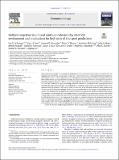Files in this item
Bedform migration in a mixed sand and cohesive clay intertidal environment and implications for bed material transport predictions
Item metadata
| dc.contributor.author | Lichtman, Ian D. | |
| dc.contributor.author | Baas, Jaco H. | |
| dc.contributor.author | Amoudry, Laurent O. | |
| dc.contributor.author | Thorne, Peter D. | |
| dc.contributor.author | Malarkey, Jonathan | |
| dc.contributor.author | Hope, Julie A. | |
| dc.contributor.author | Peakall, Jeffrey | |
| dc.contributor.author | Paterson, David M. | |
| dc.contributor.author | Bass, Sarah J. | |
| dc.contributor.author | Cooke, Richard D. | |
| dc.contributor.author | Manning, Andrew J. | |
| dc.contributor.author | Davies, Alan G. | |
| dc.contributor.author | Parsons, Daniel R. | |
| dc.contributor.author | Ye, Leiping | |
| dc.date.accessioned | 2018-06-12T10:30:06Z | |
| dc.date.available | 2018-06-12T10:30:06Z | |
| dc.date.issued | 2018-08-15 | |
| dc.identifier | 252985462 | |
| dc.identifier | b77fd365-a141-402c-bfc4-f5e9a7b9ab7f | |
| dc.identifier | 85046765984 | |
| dc.identifier | 000436219300002 | |
| dc.identifier.citation | Lichtman , I D , Baas , J H , Amoudry , L O , Thorne , P D , Malarkey , J , Hope , J A , Peakall , J , Paterson , D M , Bass , S J , Cooke , R D , Manning , A J , Davies , A G , Parsons , D R & Ye , L 2018 , ' Bedform migration in a mixed sand and cohesive clay intertidal environment and implications for bed material transport predictions ' , Geomorphology , vol. 315 , pp. 17-32 . https://doi.org/10.1016/j.geomorph.2018.04.016 | en |
| dc.identifier.issn | 0169-555X | |
| dc.identifier.other | RIS: urn:413B25E130243E28F09127D8BAB582D4 | |
| dc.identifier.other | ORCID: /0000-0003-1174-6476/work/47136313 | |
| dc.identifier.other | ORCID: /0000-0001-6165-230X/work/140361417 | |
| dc.identifier.uri | https://hdl.handle.net/10023/13940 | |
| dc.description | This work was supported by the UK Natural Environment Research Council (NERC) under grant NE/I027223/1 (COHBED), by core funding from NERC to the National Oceanography Centre, and by a NERC PhD studentship to the first author. David Paterson received funding from the Marine Alliance for Science and Technology for Scotland (MASTS), funded by the Scottish Funding Council (grant reference HR09011) and contributing institutions. Andrew Manning’s contribution to this manuscript was partly funded by HR Wallingford Company Research project ‘FineScale - Dynamics of Fine-grained Cohesive Sediments at Varying Spatial and Temporal Scales’ (DDY0523). | en |
| dc.description.abstract | Many coastal and estuarine environments are dominated by mixtures of non-cohesive sand and cohesive mud. The migration rate of bedforms, such as ripples and dunes, in these environments is important in determining bed material transport rates to inform and assess numerical models of sediment transport and geomorphology. However, these models tend to ignore parameters describing the physical and biological cohesion (resulting from clay and extracellular polymeric substances, EPS) in natural mixed sediment, largely because of a scarcity of relevant laboratory and field data. To address this gap in knowledge, data were collected on intertidal flats over a spring-neap cycle to determine the bed material transport rates of bedforms in biologically-active mixed sand-mud. Bed cohesive composition changed from below 2 vol% up to 5.4 vol% cohesive clay, as the tide progressed from spring towards neap. The amount of EPS in the bed sediment was found to vary linearly with the clay content. Using multiple linear regression, the transport rate was found to depend on the Shields stress parameter and the bed cohesive clay content. The transport rates decreased with increasing cohesive clay and EPS content, when these contents were below 2.8 vol% and 0.05 wt%, respectively. Above these limits, bedform migration and bed material transport was not detectable by the instruments in the study area. These limits are consistent with recently conducted sand-clay and sand-EPS laboratory experiments on bedform development. This work has important implications for the circumstances under which existing sand-only bedform migration transport formulae may be applied in a mixed sand-clay environment, particularly as 2.8 vol% cohesive clay is well within the commonly adopted definition of “clean sand”. | |
| dc.format.extent | 3308425 | |
| dc.language.iso | eng | |
| dc.relation.ispartof | Geomorphology | en |
| dc.subject | Bedform migration | en |
| dc.subject | Sediment transport | en |
| dc.subject | Mixed cohesive clay-sand | en |
| dc.subject | Physical and biological cohesion | en |
| dc.subject | Current and wave forcing | en |
| dc.subject | Tidal flats | en |
| dc.subject | QE Geology | en |
| dc.subject | GE Environmental Sciences | en |
| dc.subject | GC Oceanography | en |
| dc.subject | NDAS | en |
| dc.subject.lcc | QE | en |
| dc.subject.lcc | GE | en |
| dc.subject.lcc | GC | en |
| dc.title | Bedform migration in a mixed sand and cohesive clay intertidal environment and implications for bed material transport predictions | en |
| dc.type | Journal article | en |
| dc.contributor.sponsor | NERC | en |
| dc.contributor.institution | University of St Andrews. School of Biology | en |
| dc.contributor.institution | University of St Andrews. Sediment Ecology Research Group | en |
| dc.contributor.institution | University of St Andrews. Marine Alliance for Science & Technology Scotland | en |
| dc.contributor.institution | University of St Andrews. Scottish Oceans Institute | en |
| dc.contributor.institution | University of St Andrews. St Andrews Sustainability Institute | en |
| dc.identifier.doi | https://doi.org/10.1016/j.geomorph.2018.04.016 | |
| dc.description.status | Peer reviewed | en |
| dc.identifier.grantnumber | NE/I02478X/1 | en |
This item appears in the following Collection(s)
Items in the St Andrews Research Repository are protected by copyright, with all rights reserved, unless otherwise indicated.

